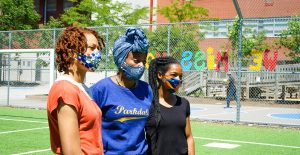Anti- Black racism at Queen Victoria PS: how serious is the TDSB about it?
“I’m glad you bought my “sorrowful” goodbye to you in December. Really, I was thinking ding-dong, the witch is gone! I’m so happy to see you leave. You and your little crew that made everything about black this and that. So what, white people don’t count? The pushing your way through classrooms the way you did in November… I mean I never even got a thank you when I bought lunch for ALL of you. Ungrateful!…Well, got rid of (redacted). Now I got rid of you just have a few more on the list to go.”
The nasty words above, lit the match – but there was plenty to burn. Over 18 months ago, Jamea Zuberi, Vice Principal of Queen Victoria PS downtown, received this hateful email. The Toronto District School Board (TDSB) immediately put her on leave along with 5 other Black teachers referenced in the letter. No explanation was given to the school community about this, though Toronto Police Service was called in to investigate this possible hate crime. They dropped the matter a few months later.
leave along with 5 other Black teachers referenced in the letter. No explanation was given to the school community about this, though Toronto Police Service was called in to investigate this possible hate crime. They dropped the matter a few months later.
Parents Tania Daley, Debbie King and Naomi Joseph with Queen Victoria Black Students for Success (QVBSS) didn’t have much luck when they tried to find out more about the letter and what led up to it. The TDSB had dropped a cone of silence over the whole matter. A year ago, they went public with 18 other alleged incidents of anti-Black racism regarding the school and former Queen Victoria Principal Alana Hardy, who, they said, obstructed their attempts to improve the lot of Black students and culture. Ms. Hardy was put on leave and later moved from the school. Superintendents who mishandled the issue, were subbed out for other superintendents. The TDSB apologized for the mess and hired lawyer Esi Codjoe, from the firm Turnpenny Milne LLP, to investigate what went wrong here as well as with other racist incidents said to have happened at the school.
Last December, about a year after the above letter went out, the Board sent an update to the Queen Victoria School community explaining that there wasn’t enough evidence “on a balance of probabilities” to identify who sent the letter. A report on that investigation wouldn’t be released. Ms. Codjoe would continue to investigate other racist incidents at the school. In the meantime, the TDSB came up with a list of parent workshops and professional development aimed at “anti-oppression, anti-racism and anti-colonial discourses” among other topics; something needed to be seen to be done.
That was all until earlier last month when the TDSB released the final report from Turnpenny Milne that described other anti-Black racist incidents at Queen Victoria that should have been “early warning signs” that there were deeper problems at the school. The law firm interviewed 46 witnesses.
Systemic anti-Black Racism
The report supported the allegations of long-standing and unresolved anti- Black racism at Queen Victoria. Black parents, particularly women, were treated differently from White parents when, for instance, they made requests for information from the school – treated as though they were being pushy or as Ms. Codjoe noted, associating stereotypes of the “..angry Black woman and notions of Black women as uppity.” Black teachers at the school, seen socializing together were perceived as “engaging in a form of conspiracy.” Witnesses explained that Black teachers were spoken over and ignored at meetings, their contributions diminished compared to those of other teachers.
Ms. Codjoe added in the report, that most of the students in the Gifted stream at the school were White while those in the regular stream were Black. Black students were reported to be treated differently than their White classmates. Overall, her report found the “evidence indicates experiences of a tiered system within QVPS, common among both teachers and students, that resulted in differential treatment with a perceived connection to race.” Despite these serious problems, nothing was done at the school to address them.
The racist letter
As for the racist hate mail, bureaucratic process and confidentiality trumped openness and clarity. The report said that the TDSB missed opportunities to reduce harm brought about by the letter, despite being told that doing nothing, delaying help to victims or restoring relations between people at Queen Victoria “could result in a poisoned work environment.” Staff affected by the letter couldn’t discuss, even amongst themselves, the incident and the racism surrounding it and their workplace.
TDSB missed opportunities to reduce harm brought about by the letter, despite being told that doing nothing, delaying help to victims or restoring relations between people at Queen Victoria “could result in a poisoned work environment.” Staff affected by the letter couldn’t discuss, even amongst themselves, the incident and the racism surrounding it and their workplace.
Members of the broader Queen Victoria school community were left out of the loop. This was one of the main complaints of QVBSS, who like others, couldn’t be sure they or their kids were safe at the school while they were largely ignored or hindered in their efforts to find out what was going on as the Board was “primarily concerned with preserving confidentiality and the integrity of evidence” over transparency.
The Human Rights Office
This is where people working in and attending TDSB schools and facilities turn for investigation of complaints over poor treatment, mediation of issues, conflict resolution and so on. Yet the report noted half of its work is unrelated to human rights issues. It added that the Human Rights Office (HRO) is understaffed, lacking in clear direction and poorly co-ordinated with a related department, Employee Services. Witnesses reported that the HRO staff can be stubbornly resistant, denying certain behaviours as racist, more “upset about being called racist than the alleged racism itself.”
The TDSB’s own Human Rights Annual Report 2018- 2020 said that the Board has a serious racism problem – race and related grounds make up 54 percent of the complaints to the Human Rights Office. As of September 2020, there were 343 outstanding complaints; they can take years to resolve. Ms. Codjoe heard that the HRO’s broad and sometimes conflicting mandates makes it difficult for staff to do their jobs, in particular “serving the Board’s most vulnerable populations, including racialized and low-income students.”
The Multi-Year Strategic Plan (MYSP)
The TDSB has been around for 23 years. Before that, it was well-known in the previous boards amalgamated to create it, that racism –in all its forms – has been a longstanding problem. But as Ms Codjoe suggested in the report, plans are more aspirational than operational: “We did not receive evidence that provides a clear indication of where the Board is in terms of achieving the equity-focused goals stated in the MYSP.” For instance, the plan to “Combat various forms of discrimination …through human rights training” has no timeline attached. It’s also not at all specific.
It’s particularly telling that she noted the disconnect between Board equity policies and real action when a problem crops up. She noted a “lack of transparency and accountability in the Board’s responses to Anti-Black Racism.” That much was clear at Queen Victoria.
Staff Training
 Again, this is a school board with a lot of experience writing policy and procedures. The problem occurs when someone is actually called upon to do something about racism or equity.
Again, this is a school board with a lot of experience writing policy and procedures. The problem occurs when someone is actually called upon to do something about racism or equity.
“ Create and implement a plan to provide ongoing sustained job-embedded learning for relevant staff (including principals, vice-principals, teachers, support staff, coaches, guidance, Student Success teacher, Community Support Workers) to understand anti-Black racism, anti-oppression and its implications on all aspects of teaching and learning as described in Inclusive Design and other anti-racism frameworks (2018 and ongoing)
The above plan from a document about improving the education of Black students is an example of this: long on aspiration, but short on what to do and how to do it. It’s carefully worded, like many other TDSB documents, to include all the required terms and staff. But, as Esi Codjoe wrote in the report, witnesses explained what ought to happen to support equity, but the reality at local schools was quite different. Lack of continuity of training and basic comprehension suggested that “anti-racism and anti-oppression were not actually priority interests.”
Recommendations from the report
Despite the report’s insights, its recommendations, along with the TDSB responses really fall short of the mark. It reads as a polite, bureaucratic conversation. Ms. Codjoe offers a suggestion for system adjustment and the Board offers a policy or procedure change, coached in the same careful language that is so typical of Board communications- stripped of any vision or larger grasp of the problem.
Recommendations:
-
-
-
- The Board should develop a protocol for incidents like the racist letter and communicate better with affected people, staff and community members.
-
-
-
-
-
- The TDSB should also “provide facilitation and restoration services…at the early stages of conflicts…” though unclear, perhaps this means to offer more help, opportunity to speak and the support that can comes from discussion and transparency.
-
-
-
-
-
- This would include better communication with expert Board staff who in some unspecified way should advise superintendents how to work with local school principals to handle tough situations involving hate and racism.
-
-
The TDSB replied it would “effectively respond to these occurrences through early resolution…” implementing vague “remedial and proactive prevention measures.” It now requires any TDSB employee to report racist, hate/bias and criminal hate activities involving or affecting any students in the school community. This last point is referred to in PROCEDURE 728 REPORTING AND RESPONDING TO RACISM AND HATE INCIDENTS INVOLVING OR IMPACTING STUDENTS IN SCHOOLS. What’s missing from this is mention of consequences for not reporting such incidents as well the assurance of confidentiality for people who do. It also specifies students – not other members of the school community.
To its credit, the TDSB does have a simplified version of this reporting system. In light of racist problems throughout the board it would be good post it in local schools and on websites for all to see.
As for a quick response to incidents, TDSB said that, in future it would mobilize the Organizational Response Team of experts like Human Rights Office, Caring/ Safe Schools and Communications staff along with community friends and others to quickly advise the local administrators about how to manage a situation like that at Queen Victoria: investigation communication, developing “post incident measures” and the like.
-
-
-
- The Human Rights Office should stick to its job and that job should be more clearly defined. The Board should also look to experts on human rights to help staff avoid or mitigate situations like what occurred at Queen Victoria.
-
-
The TDSB has expanded the overworked HRO by 10 people and is rewriting policies and procedures to transfer non-human rights complaints to the Employee Services department. Given the number of outstanding HRO complaints and the fact half of them are focused on race, it really does remain to be seen whether the HRO has the staff or the will to follow up on racist and hate incidents.
-
-
-
- Roll out anti-racism training, particularly regarding anti-Black racism for educators including upper level administrators like superintendents. Teachers should be able to “work through school-based fact scenarios and ask questions.”
-
-
This is a strangely vague recommendation from an investigator looking into anti-Black racism at a school. What particular training is Ms. Codjoe recommending for Queen Victoria? What specifically, do educators and for that matter, parents need to know about anti-Black racism there? The TDSB has been running or planning workshops of this sort for years and even got into particulars when it was clear last fall that anti-Black racism at Queen Victoria went beyond a disgusting email. The effort came off a bit like throwing paint at a wall to see what stuck – but included decent topics like workshops for parents and educators on experiences, barriers and success for Black students at the TDSB; disrupting anti-Black racism in elementary schools and professional development on accountability for anti-Black racism. It will continue to “intentionally plan” other workshops, whatever that means.
training is Ms. Codjoe recommending for Queen Victoria? What specifically, do educators and for that matter, parents need to know about anti-Black racism there? The TDSB has been running or planning workshops of this sort for years and even got into particulars when it was clear last fall that anti-Black racism at Queen Victoria went beyond a disgusting email. The effort came off a bit like throwing paint at a wall to see what stuck – but included decent topics like workshops for parents and educators on experiences, barriers and success for Black students at the TDSB; disrupting anti-Black racism in elementary schools and professional development on accountability for anti-Black racism. It will continue to “intentionally plan” other workshops, whatever that means.
-
-
-
- This training should focus on the term “misogynoir” or anti-Black misogyny since ”Black women experience anti-Black racism in unique ways.”
-
-
The TDSB agreed with this point and “is committed to building capacity and expertise” to focus on this problem.
Upper level administrators at the TDSB must think that parents and front-line staff are uncritical or careless to believe the pablum it spoons out to deal with deadly serious matters like anti-Black racism or other hate and race-based issues. The process from the beginning has been an exercise in artful distraction. There is no leadership, no solid commitment to fundamental principles of equity in any of this. The buck stops nowhere. The fundamental questions remain:
What is going to happen at Queen Victoria Public School to deal with the issues that came forward?
-
-
-
- Why could no one could find the racist letter writer when the clues were substantial?
- What of the many complaints made by QVBSS regarding the principal who say denied them information about students’ academic needs, told they couldn’t hold a meeting on school property? On behalf of the TDSB, Media Relations Manager Ryan Bird, said that further details will come out in the “final phase of the report.”
- What is going to happen to improve the work environment at the school in light of the systemic racism problem Ms. Codjoe reports?
- What is going to happen at the school to ensure that Black women seeking information aren’t treated as “uppity?”
-
-
Critically, what disciplinary or accountability measures is the TDSB willing to take to deal with racist incidents? Again, this is undecided, as the Board awaits the above final report.
What about people who just don’t do their jobs properly? We probably won’t find out specifics about the principal Ms. Hardy, or the superintendents Sandra Tondat and Sandy Spyropoulos all of whom were moved off the case, but what should be done about middle and upper level administrators who get into so much difficulty? The Board refers back to the Organizational Response Teams in hopes that they will steer administrators in the right direction. Upper level Board staff know better than that and need to commit to holding leaders, including themselves accountable when things go wrong.
QVBSS
Tania Daley, Debbie King and Naomi Joseph of Queen Victoria Black Students for Success (QVBSS) raised these issues of anti-Black racism 18 months ago and have suffered for their efforts – ignored, chastised and even followed home one evening.
Tania Daley and Debbie King pointed out, in a recent interview, the circular thinking of the whole process of this investigation: someone identifies a huge gap between Board policies and what actually happens in a school; the Board resists it, then hires someone to investigate, writes more policies and procedures and carries on in much the same way, monitoring itself over the changes it agrees to make. They likened it to a “circus” of highly paid, well organized performers overseeing a system of “polite apartheid” in which outcomes for Black students don’t substantially change.
Because no one has yet been held accountable for what happened at Queen Victoria, they say it sends a message to racist staff and bureaucracy “it’s business as usual.” They are continuing to pursue their complaints about anti-Black racist incidents at the school with the Human Rights Tribunal of Ontario (HRTO).
The last words go to them:
“How will TDSB ‘fortify new measures with a system-wide commitment’, while continuing to employ leaders who uphold the opposite? Perhaps the ‘approach the system needs to re-examine’ has nothing to do with policy and everything to do with personnel. New leadership is needed not only at the Director level, but throughout the ranks for a distinct dismantling and shift in culture.”


